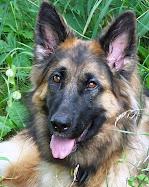- First it was the squirrel... well documented in this post call "There's a squirrel in my basement!.
- Then one day as I'm walking though my bedroom I noticed something on the rug... humm.. dead mouse. Could have been worse - it could have been buried in the bed so I guess all things considered, it was OK.
- Yesterday, I was heading downstairs to do laundry again and saw something at the bottom of the stairs... my first thought ... a brush Jake had chewed up. As I got closer I realized that no... it was not a brush but rather a bird - a blackbird. - very dead. SO... I put the dogs in another room and looked for a pooper scooper and scooped it up. I realized then, it hadn't been dead for very long!!

Squirrel - mouse - blackbird - what next? All this in the last year when - YOU KNOW WHO - arrived on the scene!! The only other thing I've seen caught in the yard was a bunny (stupid bunny for coming in the yard) and it didn't last long!! Those dogs are gone now and I haven't seen a bunny since.
-
June 10, 2011 – walked out on my deck…. woodpecker… dead as a door nail.
-
June 28, 2011 – 6:30 am… a bit drowsy – in kitchen – commotion in living room – turn to watch Jake crash through stools and catch a chipmunk, drop it, look at it, look at me as if to say “there.. it’s yours”. (unlike Kobie who would have run with it to the woods and enjoyed it for breakfast.) I encouraged him to take it outside which he did as I surveyed the mess in my living room!!
Just a PS written in 2022 and yes Jake is still around at 12 years old. He has (in no particular order)...:
****dumped a possum on the porch that wasn't dead but playing possum.. He wanted to bring it in the house.
.****brought a large DEAD male possum to the garage that needed a show shovel to remove in the rain.
****caught and ate a groundhog. Apparently they are pretty tasty because he had no desire to eat the above 2 possum described and the others I found around the year.
****delighted in stalking, catching and killing innocent doves who were simply foraging in the grass.
****caught and consumed numerous rabbits as he learned to do from Brita who learned it from Ari who was taught by Josephine.
WHAT A GUY!!

























